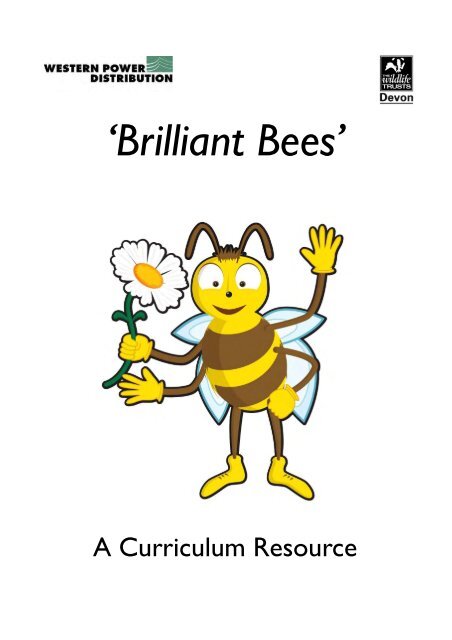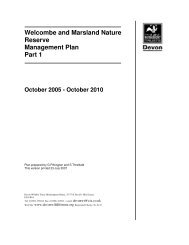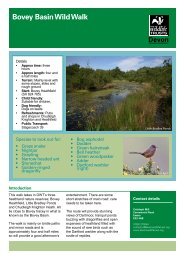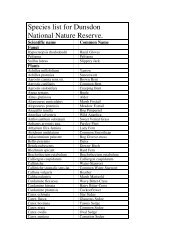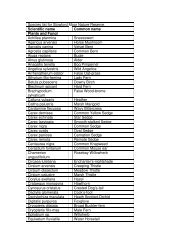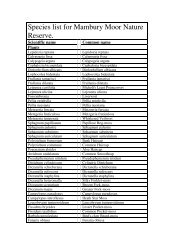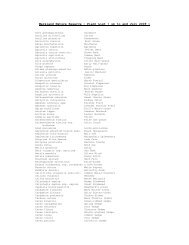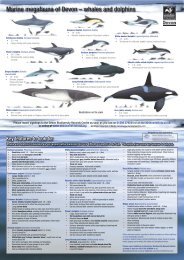Brilliant Bees Curriculum Resource Pack - Devon Wildlife Trust
Brilliant Bees Curriculum Resource Pack - Devon Wildlife Trust
Brilliant Bees Curriculum Resource Pack - Devon Wildlife Trust
You also want an ePaper? Increase the reach of your titles
YUMPU automatically turns print PDFs into web optimized ePapers that Google loves.
‘<strong>Brilliant</strong> <strong>Bees</strong>’<br />
A <strong>Curriculum</strong> <strong>Resource</strong>
This curriculum resource has been produced by <strong>Devon</strong> <strong>Wildlife</strong><br />
<strong>Trust</strong> with the kind support of Western Power Distribution.<br />
www.devonwildlifetrust.org<br />
Charity number 213224
‘Bee Friendly’ Day<br />
<strong>Brilliant</strong> <strong>Bees</strong> – A <strong>Curriculum</strong> <strong>Resource</strong><br />
1. Bring a Buzz to your <strong>Curriculum</strong> Activities – Outline for a ‘Bee Friendly’ Activity Day 5<br />
2. <strong>Curriculum</strong> Links for a “Bee Friendly” Day 7<br />
3. Bee and Me Literacy Activities 8<br />
4. Bee facts for Numeracy Activities 11<br />
5. Hexagons 12<br />
6. Scientific Research – British <strong>Bees</strong> 14<br />
7. Life Cycle of a Bee 15<br />
8. Anatomy of a Honey Bee 18<br />
9. Make a Bee Mobile 19<br />
10. Make a Paper Plate Bee 21<br />
11. Recipes with Honey 22<br />
12. Waggle Dance Game 24<br />
13. Make a Bee Friendly Hotel 30<br />
14. Make a Deluxe Bee Hotel 31<br />
15. Marking out a Bee Garden 33<br />
3
Background<br />
“Bee Friendly” Day<br />
Bringing a Buzz to your <strong>Curriculum</strong> Activities<br />
There are over 250 species of bee in Great Britain, 24 bumblebees, the honeybee and numerous<br />
types of solitary bee. <strong>Bees</strong> are a key species for pollinating flowers and plants, it is estimated that<br />
the honeybee alone is worth in excess of £200 million to UK agriculture (BBC article March<br />
2011). However, many of these species have declined in number over recent years, causing<br />
concern amongst conservationists and economists alike.<br />
Bee friendly day<br />
The “Bee Friendly” day has been created in order to introduce school children to bees and how<br />
valuable they are to other plants and animals. Children will learn about the different species of<br />
bee that exist in the UK, have the opportunity to understand about their life cycle, play the<br />
“waggle dance” game, meet a beekeeper*, plant bee friendly seeds, and make bee homes. There<br />
will also be a variety of activities designed to stimulate students within curriculum topics such as<br />
Science, Art, Literacy and Numeracy across the age ranges. Schools will be able to choose from a<br />
range of activities depending on the age and ability of the students taking part.<br />
Making a<br />
Bee Hotel *<br />
Planting in<br />
grounds<br />
or pots*<br />
Waggle<br />
dance<br />
game*<br />
Beekeeping<br />
Making<br />
honey<br />
Cooking<br />
with honey<br />
Practical<br />
PE<br />
DT<br />
Survey<br />
Science<br />
Distances Shapes<br />
(hexagons)<br />
“Big<br />
numbers”<br />
Art<br />
Life cycle<br />
Research<br />
different species<br />
Paper<br />
* indicates SEAL links plate bees<br />
Make “junk”<br />
(empathy, teamwork,<br />
communication etc)<br />
bees<br />
<strong>Curriculum</strong> Links for a “Bee Friendly” Day<br />
Numeracy<br />
Bee<br />
mobiles*<br />
Write a story<br />
“Life without<br />
<strong>Bees</strong>” *<br />
5<br />
Weight<br />
Hexagonal<br />
patterns<br />
Assembly<br />
Introducing the world of<br />
bees (DWT)<br />
Literacy<br />
Read a story for<br />
inspiration – “ Bee & Me”<br />
Elle J. McGuiness<br />
Respond with<br />
key words to a<br />
clip from bee<br />
movie*<br />
Poetry about<br />
bees
Outline for the day<br />
“Bee Friendly” Day<br />
Bringing a Buzz to your <strong>Curriculum</strong> Activities<br />
This is an example programme, there are many possible variations based on the curriculum links<br />
diagram.<br />
9:00 Assembly - All students are introduced to the world of bees and the aims of the day.<br />
(DWT Education officer)<br />
9:30 – 10:00 – First activity:<br />
KS1- Bee movie clip / story. Literacy activity responding to a world without bees<br />
KS2 – The science of bees – different bee species, making honey and life cycles, how bees have<br />
been used in history.<br />
11:00 – 12:00 – Second activity<br />
Break<br />
KS1 – PE Waggle dance game. Introduce students to the waggle dance and play the<br />
communication game.<br />
KS2 – Literacy activity. Poetry / story-writing about life without bees.<br />
1:00-2:00 – Third activity<br />
Lunch<br />
KS1 – DT / Art. Half the group making Bee Hotels or Cooking with Honey recipes while the<br />
others create Bee Mobiles, Paper Plate <strong>Bees</strong> etc.<br />
KS2 – Waggle dance activity<br />
2:00 – 3:00 – Fourth Activity<br />
KS1- Plant a bee friendly plant. Practical activity to change the school grounds to be more bee<br />
friendly.<br />
KS2 – DT – making bee hotels, planting bee friendly plants<br />
3:00-3:10 – Plenary time. What have we learned?<br />
Close<br />
6
Planting in<br />
grounds<br />
or pots*<br />
Waggle<br />
dance<br />
game*<br />
Beekeeping<br />
Making<br />
honey<br />
Making a<br />
Bee Hotel *<br />
DT<br />
Science<br />
Life cycle<br />
Research<br />
different species Paper<br />
plate bees<br />
* indicates SEAL links<br />
(empathy, teamwork,<br />
communication etc)<br />
Practical<br />
PE<br />
Cooking<br />
with honey<br />
Survey<br />
<strong>Curriculum</strong> Links for a “Bee Bee Friendly” Friendly Day<br />
Distances<br />
Art<br />
Make “junk”<br />
bees<br />
Numeracy<br />
“Big<br />
numbers” Weight<br />
Bee<br />
mobiles*<br />
7<br />
Write a story<br />
“Life without<br />
<strong>Bees</strong>” *<br />
Shapes<br />
(hexagons)<br />
Hexagonal<br />
patterns<br />
Assembly<br />
Introducing the world of<br />
bees (DWT)<br />
Literacy<br />
Read a story for<br />
inspiration – “ Bee & Me”<br />
Elle J. McGuiness<br />
Respond with<br />
key words to a<br />
clip from bee<br />
movie*<br />
Poetry about<br />
bees
For Key Stage 1:<br />
Literacy <strong>Resource</strong> “Bee & Me”<br />
By Elle J. Mcguinness - Andrews McMeel<br />
ISBN 0740777343<br />
Synopsis of story…<br />
‘Bee Friendly’ Day<br />
Bee and Me Literacy Activities<br />
“When a young boy discovers a bee trapped in his<br />
bedroom he hides for fear of being stung. But when<br />
the amiable bee frantically explains all that bees do,<br />
the boy comes to understand how good things come<br />
in different packages.”<br />
Activity<br />
Start the students thinking about how they feel about bees. Are they afraid of them? Why? Why not?<br />
Read the story with the students and take time to discuss what the bee is like, what it does and how the<br />
boy’s attitude towards the bee changes during the course of the story.<br />
Follow up – Using the blank outline of a bee shape, the children can write or draw the words that they<br />
think best describe the bee, what it does and how they feel.<br />
Ask children to share what they have written / drawn and describe how they feel about bees after the<br />
story.<br />
N.C. Links<br />
Knowledge, skills and understanding<br />
Speaking<br />
1. To speak clearly, fluently and confidently to different people, pupils should be taught to:<br />
• choose words with precision<br />
• organise what they say<br />
• focus on the main point(s)<br />
8
Listening<br />
‘Bee Friendly’ Day<br />
Bee and Me Literacy Activities<br />
2. To listen, understand and respond to others, pupils should be taught to:<br />
• sustain concentration<br />
• remember specific points that interest them<br />
• make relevant comments<br />
• listen to others' reactions<br />
• ask questions to clarify their understanding<br />
Group discussion and interaction<br />
3. To join in as members of a group, pupils should be taught to:<br />
• take turns in speaking<br />
• relate their contributions to what has gone on before<br />
• take different views into account<br />
• extend their ideas in the light of discussion<br />
• give reasons for opinions and action<br />
Key Stage 2<br />
Literacy resource – Bee Movie DVD<br />
Use Chapters 13-15 (or 13 and 15 for short version) (Timings 1:02-1:17)<br />
Synopsis of the story prior to clip<br />
“Barry the Bee is a drone but wants to be a “jock”. He<br />
realises that humans take their honey and campaigns to<br />
legally stop them getting it. He wins but does not realise the terrible consequences of his actions. We join<br />
the story as it begins to unfold…can they find a solution before it is too late?”<br />
Activity<br />
Before watching the clip, ask the students to consider what the world would be like without bees. What<br />
do they think bees do for us?<br />
Ask them to watch the video clip really carefully and write down words that describe what they see and<br />
how bees affect the world around them.<br />
Take feedback and develop key words from what the students have gathered from the clip. Ask students<br />
to write a response – a story or poem etc… to describe a world without bees or how important they are.<br />
9
N.C. Links<br />
Knowledge, skills and understanding<br />
Speaking<br />
‘Bee Friendly’ Day<br />
Bee and Me Literacy Activities<br />
1. To speak with confidence in a range of contexts, adapting their speech for a range of purposes and audiences, pupils<br />
should be taught to:<br />
• choose material that is relevant to the topic and to the listeners<br />
• show clear shape and organisation with an introduction and an ending<br />
Listening<br />
2. To listen, understand and respond appropriately to others, pupils should be taught to:<br />
• identify the gist of an account or key points in a discussion and evaluate what they hear<br />
• ask relevant questions to clarify, extend and follow up ideas<br />
• recall and re-present important features of an argument, talk, reading, radio or television programme, film<br />
• identify features of language used for a specific purpose [for example, to persuade, instruct or entertain]<br />
• respond to others appropriately, taking into account what they say.<br />
Group discussion and interaction<br />
3. To talk effectively as members of a group, pupils should be taught to:<br />
• make contributions relevant to the topic and take turns in discussion<br />
• vary contributions to suit the activity and purpose, including exploratory and tentative comments where ideas are being<br />
collected together, and reasoned, evaluative comments as discussion moves to conclusions or actions<br />
• qualify or justify what they think after listening to others' questions or accounts<br />
• deal politely with opposing points of view and enable discussion to move on<br />
• use different ways to help the group move forward, including summarising the main points, reviewing what has been said,<br />
clarifying, drawing others in, reaching agreement, considering alternatives and anticipating consequences.<br />
10
‘Bee Friendly’ Day<br />
Bee Facts for Numeracy Activities<br />
1. How many flowers must honey bees tap to make one pound of honey?<br />
Two million<br />
2. How many flowers does a honeybee have to visit to gather a load of pollen?<br />
1500 flowers<br />
3. How far does a hive of bees fly to bring you one pound of honey?<br />
Over 55,000 miles<br />
4. How large an area does a honeybee have to cover to collect a load of pollen?<br />
Approximately 12 square miles<br />
5. How much honey does the average worker honeybee make in her lifetime?<br />
1/12 teaspoon<br />
6. How heavy is a load of pollen?<br />
Approximately 10 mg<br />
7. How fast does a honey bee fly?<br />
About 15 miles per hour / 24 kilometres per hour<br />
8. How much honey would it take to fuel a bee's flight around the world?<br />
About one ounce<br />
9. How long does a worker honeybee live?<br />
Approximately 42-45 days in peek season<br />
10. How long have bees been producing honey from flowering plants?<br />
10-20 million years<br />
11. You have to go through approximately one tonne of honey to gather approximately<br />
20 lb. of bees wax. Approximately 9 kg<br />
12. How many sides does each honeycomb cell have?<br />
Six<br />
13. Honeybees make flakes of wax no larger than a pinhead.<br />
It takes 500,000 flakes of wax to make one pound of bees wax. Less than 1/2 kg<br />
14. How many kilograms of honey do bees have to consume to make one kilogram of bees wax?<br />
Eighteen kilograms of honey, almost 40 lbs. of honey<br />
15. How many wings does a honeybee have?<br />
Four<br />
16. How many Honey <strong>Bees</strong> are there in a hive?<br />
In a strong hive there are 70,000 - 100,000 <strong>Bees</strong> in a hive<br />
11
‘Bee Friendly’ Day<br />
Hexagons<br />
<strong>Bees</strong> make honeycomb using hexagons.<br />
What patterns or pictures can you create using only hexagons?<br />
12
‘Bee Friendly’ Day<br />
Hexagons<br />
13
Mining Bee<br />
(Andrena haemorrhoa)<br />
Early Bumblebee<br />
(Bombus pratorum)<br />
European Honeybee<br />
(Apis mellifera)<br />
‘Bee Friendly’ Day<br />
Scientific Research – British Bee Species<br />
Nigel Jones Nigel Jones<br />
Iofaesofa<br />
Larces<br />
Pictures from Creative Commons on Flickr<br />
Photographers credited<br />
14<br />
Red Mason Bee<br />
(Osmia rufa)<br />
Leaf Cutter Bee<br />
(Megachile willghbiella)<br />
Here are just a few of the 250+<br />
species of bee that live in Great<br />
Britain.<br />
Nigel Jones<br />
Can you find out more about<br />
just one species and tell other<br />
people about it through a poster,<br />
presentation or leaflet?
Max XX<br />
2. The workers feed<br />
the growing larva…<br />
‘Bee Friendly’ Day<br />
Life Cycle of a Bee<br />
15<br />
1. The Queen Bee lays<br />
eggs in the individual<br />
chambers.<br />
Chantal Foster<br />
3. …until it is fully<br />
grown.<br />
(All images from Flickr Creative Commons.<br />
Photographers credited)
4. The workers then<br />
seal the chamber<br />
with wax.<br />
Chantal Foster<br />
6. …they finally emerge<br />
through the wax as a<br />
newborn Bee!<br />
All images from Flickr Creative Commons.<br />
(Photographers credited)<br />
‘Bee Friendly’ Day<br />
Life Cycle of a Bee<br />
16<br />
Max XX<br />
5. The larva turn into<br />
pupa inside the<br />
chamber (this one is<br />
a Queen) until…<br />
Max XX
‘Bee Friendly’ Day<br />
Life Cycle of a Bee<br />
Now, have a go at drawing your own life cycle for a honey bee.<br />
The cells are drawn for you!<br />
1 2 3<br />
4 5 6<br />
17
Add these words to the correct arrows…<br />
Head<br />
Antennae<br />
Sting<br />
‘Bee Friendly’ Day<br />
Anatomy of a Honey Bee<br />
Eye<br />
Hind Leg<br />
Middle Leg<br />
Pictures from Creative Commons on Flickr<br />
18<br />
Striving to a goal<br />
Foreleg<br />
Thorax<br />
Abdomen<br />
Wing
You will need…<br />
Yellow, black and white card<br />
What to do… for bees…<br />
‘Bee Friendly’ Day<br />
Make a Bee Mobile<br />
Sellotape<br />
Twine / string<br />
Scissors<br />
1. Roll a length of the yellow card –<br />
the best size is approximately the same<br />
as an empty toilet roll. Sellotape or<br />
glue in place to create the body.<br />
2. Cut strips from the black card and<br />
glue onto the main body for the<br />
stripes. You will also need to cut<br />
antennae and a sting to attach.<br />
19<br />
Cardboard<br />
tube<br />
(optional)<br />
Glue<br />
Two<br />
sticks<br />
Side view<br />
Side view
for mobile…<br />
‘Bee Friendly’ Day<br />
Make a Bee Mobile<br />
3. From the white card, cut a<br />
circle, just smaller than the end of<br />
the roll. Add tabs so that it can be<br />
attached. Draw on a face and<br />
attach antennae to make the head.<br />
4. With the remaining white card,<br />
cut out wings and glue them to the<br />
top of the roll.<br />
Front view<br />
Top view<br />
Tie two sticks together to form a<br />
cross. Leave a length of extra string<br />
attached - this will be used to hang<br />
the finished mobile from the ceiling.<br />
Attach the individual bees onto each<br />
of the points with twine or string.<br />
You can add a flower from the centre<br />
for added decoration.<br />
20
You will need…<br />
What to do…<br />
Tissue paper<br />
One pipe<br />
cleaner<br />
(for sting)<br />
1. Turn the plate over<br />
and paint yellow<br />
(leave to dry)<br />
2. Paint on<br />
black stripes<br />
‘Bee Friendly’ Day<br />
Make a Paper Plate Bee<br />
Googly eyes<br />
Paper<br />
plate<br />
21<br />
3. Stick<br />
on eye<br />
Yellow and<br />
black paint<br />
Paint brush<br />
4. Make wings from tissue paper<br />
and stick to underside of bee.<br />
5. Use pipe<br />
cleaner for sting
1. Honey Cornflake Cups<br />
Serves: 12<br />
Ingredients<br />
90g butter<br />
90g sugar<br />
1 tablespoon honey<br />
120g cornflakes<br />
Method<br />
‘Bee Friendly’ Day<br />
Recipes with Honey<br />
1. Melt the butter, sugar and honey in a saucepan until sugar is dissolved and mixture is frothy.<br />
2. Pour the mixture over the cornflakes until all the cornflakes are coated.<br />
3. Place 12 large patty cake cups on a tray and spoon the mixture<br />
into the cups. Put the tray into a 150°C (Gas mark 2)oven for 12 minutes or until slightly golden.<br />
4. Once out of the oven leave cups on the tray to cool a little and harden. Keep in an airtight container.<br />
2. Honey Biscuits<br />
Makes about 30 biscuits<br />
Ingredients<br />
175g/6oz. plain flour<br />
75g/3oz. white granulated sugar<br />
1 tsp bicarbonate of soda<br />
100g/4oz. butter or margarine (not low fat spread)<br />
1 large tbsp clear honey<br />
1 tbsp milk<br />
22<br />
u m a m i (Flickr)<br />
Perecca (Flickr)
Method<br />
‘Bee Friendly’ Day<br />
Recipes with Honey<br />
1. Warm honey and milk together and allow to cool.<br />
2. Add bicarbonate of soda and beat with fork until frothy.<br />
3. Cream the butter and sugar. Add frothy mixture and then the sieved flour.<br />
4. Roll into small equal balls (about 3 cm diameter), place on greased baking tray and press<br />
slightly with a fork.<br />
5. Bake on middle shelf for about 10 minutes in preheated oven (180°C/Gas 5), until golden.<br />
6. Leave to cool on a wire rack.<br />
3. Honey sausages<br />
Serves 4<br />
Ingredients<br />
20 cocktail sausages<br />
1 ½ tablespoons of honey<br />
2 tablespoons sesame seeds<br />
3 teaspoons sunflower oil<br />
Method<br />
1. Preheat oven to 180 °C/Gas 5<br />
2. Separate sausages and place in a roasting tin<br />
3. Drizzle over oil and roast for 30 mins<br />
4. Carefully drain off any excess oil<br />
5. Pour the honey and sesame seeds over the sausages, ensure that they are evenly coated.<br />
6. Return the sausages to the oven for a further 5 mins.<br />
23<br />
Annie Mole (Flickr)
Background<br />
The Game<br />
The aim of the game is for the students to have an idea of<br />
how teamwork is the most important aspect for the life of<br />
a colony of bees and that good communication plays a<br />
vital role in that success. It will also provide the<br />
opportunity to consider how much work bees do to<br />
create honey and give an introduction to the idea of<br />
pollination which can be followed up in the classroom.<br />
The game has been designed to have a number of layers<br />
which can be added for increased complexity and to reveal<br />
more about the life of honeybees.<br />
‘Bee Friendly’ Day<br />
Waggle Dance Game<br />
24<br />
Honeybees use a unique form of<br />
communication known as the<br />
“Waggle Dance” to inform others in<br />
the colony where there are good<br />
sources of nectar.<br />
Walking in a looping pattern, and<br />
waggling their bodies informs other<br />
bees of both the direction and<br />
distance required to find the food.<br />
For a simple video showing the dance<br />
visit: http://www.youtube.com/watch?v=-<br />
7ijI-g4jHg
Setting up<br />
At least two “hives" need to be set up with roles allocated within each.<br />
“Flowers” will also need to be paced, out of sight of the hives so that<br />
students will not be able to see them directly. (flowers can simply be pots<br />
of water with something to mark where they are)<br />
Game 1: The race for the honey (simplest)<br />
You will need:<br />
At least two teams<br />
and a base (hive) for<br />
each.<br />
Playing the game:<br />
Sources of nectar<br />
hidden on site<br />
Pipette for each bee<br />
sent out.<br />
Measurable collecting<br />
pots (test tubes)<br />
The key to this game is the non-verbal communication required to explain where<br />
the source of nectar is. Before the game begins it is important for the students to<br />
discuss how they will communicate the information in their team as once the game<br />
starts there is no verbal communication allowed!<br />
Choose 3 “scouts” to go out from the hive (more if a large area / group) These will<br />
need to be the ones who are confident in their communication skills. Give each one<br />
a pipette for collecting their “nectar.”<br />
‘Bee Friendly’ Day<br />
Waggle Dance Game<br />
25
Once the scouts have found the source of nectar, they collect some in their pipettes<br />
and return to the hive to deposit it into the honeycomb (tubes). Without speaking,<br />
they then use their agreed method to direct the next group to the nectar.<br />
If there are a number of sources, one will clearly run out after some time and scouts<br />
will need to find and communicate new locations.<br />
The game can be set for a time limit or quantity of honey collected. The winners<br />
being those who either complete their quota or collect the most in the time given.<br />
Follow up:<br />
There is a good opportunity for evaluation of communication and team skills to<br />
follow the game where students can reflect on their own participation and the<br />
success or otherwise of the team.<br />
There can also be reflection on what they have learned about the life of bees and the<br />
process of collecting the honey. (leading into the idea of pollination if wanted)<br />
Game 2: Introducing pollen<br />
To extend learning about bees and the role they play as<br />
pollinators, a layer of complexity can be added to the<br />
game. For this, you will need something to represent<br />
pollen (such as the school bean bags pictured) and a<br />
different receptacle for each team playing.<br />
‘Bee Friendly’ Day<br />
Waggle Dance Game<br />
26<br />
Suggested set up
Playing the Game:<br />
The race for the honey still applies, however students need to visit more than one<br />
of the flowers to collect the nectar. As they do so, they remove one of the<br />
“pollen” items, depositing it at the next flower visited. To keep it simple, they can<br />
only pick up and deposit once on a visit.<br />
At the end of the game, honey quantity plus successful pollinations (number of<br />
pollen in their container) determine the winners.<br />
Game 3: Enemies at the Hive (Most complex)<br />
This can be added as a layer onto game 2 or played as an extension of game one,<br />
depending on how much you want to include in it.<br />
Honey bees have a range of enemies who attack the hive for the larvae or honey.<br />
Amongst these are Mice, Hornets, Ants and notably the Death’s Head Hawkmoth<br />
which can mimic the actions and smells of bees to such an extent that it can get<br />
into the hive without being attacked. In defending the other attacks, bees will use<br />
their stings and therefore die.<br />
‘Bee Friendly’ Day<br />
Waggle Dance Game<br />
Adding enemies in the game makes the task of collection harder and increases<br />
participation and team work giving more to talk about at the end of the game!<br />
(See Enemy Cards sheet)<br />
Steve’s <strong>Wildlife</strong> wwarby Shearwater Trevor H<br />
27
Playing the Game:<br />
Same rules apply for the “Race for the Honey” or “Adding pollen” games, however,<br />
this time specific roles will need to be given within the hive and some students will<br />
need to be “enemies”. (one enemy will be added to the game every 5 mins so not<br />
many are needed)<br />
Roles in the hive are –<br />
Workers - to go out and communicate where the nectar is<br />
Guard – to defend the hive<br />
Drone – to care for bee larvae.<br />
Adding Enemies<br />
The game carries on as normal, however after 5 mins (or less) the enemy is added.<br />
This needs to be done randomly as each enemy causes a different level of harm. So if<br />
using a pack of 10 cards there should be 4 ants, 3 Mice, 2 Hornets, 1 Death’s Head<br />
Hawk Moth. Once the card has been selected and the enemy is known they go to<br />
attack the hive.<br />
Defence<br />
‘Bee Friendly’ Day<br />
Waggle Dance Game<br />
To defend the hive, the guards must sting (touch) the enemy – after which they die.<br />
Each enemy requires a different number of stings to be defeated, however, the<br />
hawkmoth perfectly mimics a queen bee and can simply walk in and eat the honey<br />
(you may want to limit it to one container)<br />
Defeating an ant takes 3 stings, a mouse needs 5 stings and a hornet takes 7. Once<br />
dead, the guards become larvae and one pipette of honey will bring them back! They<br />
then become a drone and drones are promoted to guards.<br />
28
wwarby<br />
‘Bee Friendly’ Day<br />
Waggle Dance Game<br />
Trevor H<br />
29<br />
Shearwater<br />
Steve’s <strong>Wildlife</strong>
For the Bee Hotel you will need:<br />
Piece of drainpipe<br />
(Or other round<br />
container)<br />
String<br />
1. Cut the pipe and<br />
bamboo canes to the<br />
optimum length 150mm<br />
2. Fill the pipe with<br />
the canes so that it is<br />
packed full<br />
‘Bee Friendly’ Day<br />
Make a Bee Friendly Hotel<br />
(Optimum<br />
length 150mm)<br />
Bamboo<br />
canes<br />
Hacksaw<br />
(Cut the canes below a node so that it<br />
is sealed at the end.)<br />
3. Tie the pipe tightly so<br />
that it can be hung up.<br />
(Orientate in a south –<br />
east direction)<br />
30
You will need:<br />
Wood for frame - length can vary<br />
Logs / blocks of wood for drilling<br />
Bamboo canes, wood screws<br />
What to do:<br />
1. Build the frame for your hotel.<br />
Measurements can differ<br />
according to the size of your<br />
wood.<br />
2. Cut lengths of bamboo<br />
cane and drill holes<br />
into the logs / wood.<br />
‘Bee Friendly’ Day<br />
Make a Deluxe Bee Hotel<br />
A luxury model stirebukkerbruse<br />
31<br />
Tools:<br />
Hacksaw, Saw, Drill, Screwdriver<br />
Caution needed. – Preparing timbers<br />
and drilled logs beforehand may be<br />
appropriate for younger students
3. Fill the frame with the wood and bamboo canes – ensure that it is tightly<br />
packed so that the contents do not become loose or fall out.<br />
4. Locate the hotel on a sunny wall, facing south or south east.<br />
5. Watch to see<br />
who comes to visit!<br />
‘Bee Friendly’ Day<br />
Make a Deluxe Bee Hotel<br />
Picture Esk<br />
32<br />
Pictures from Creative Commons on Flickr
You will need:<br />
Original design and planting guide can be found at Bee Happy Plants http://www.beehappyplants.co.uk/<br />
A stick / post<br />
Some rope / string<br />
Bee friendly<br />
plants<br />
Optional – boards to mark<br />
the boundaries (equal lengths)<br />
Soil /<br />
compost<br />
A spade<br />
‘Bee Friendly’ Day<br />
Marking out a Bee Garden<br />
33<br />
What to do:<br />
2. To make it more ‘Bee’<br />
focused, use the frame of the<br />
circle to create a hexagon.<br />
Making the edges with board if<br />
wanted.<br />
1. Mark a circle using the<br />
post and string. Dig out<br />
the edge with the spade to<br />
make it clear.<br />
3. Fill with soil / compost and<br />
plant with nectar-rich flowers.<br />
(see website) To extend your<br />
bed to look like a honeycomb,<br />
create further hexagons along<br />
the edges of the original.


